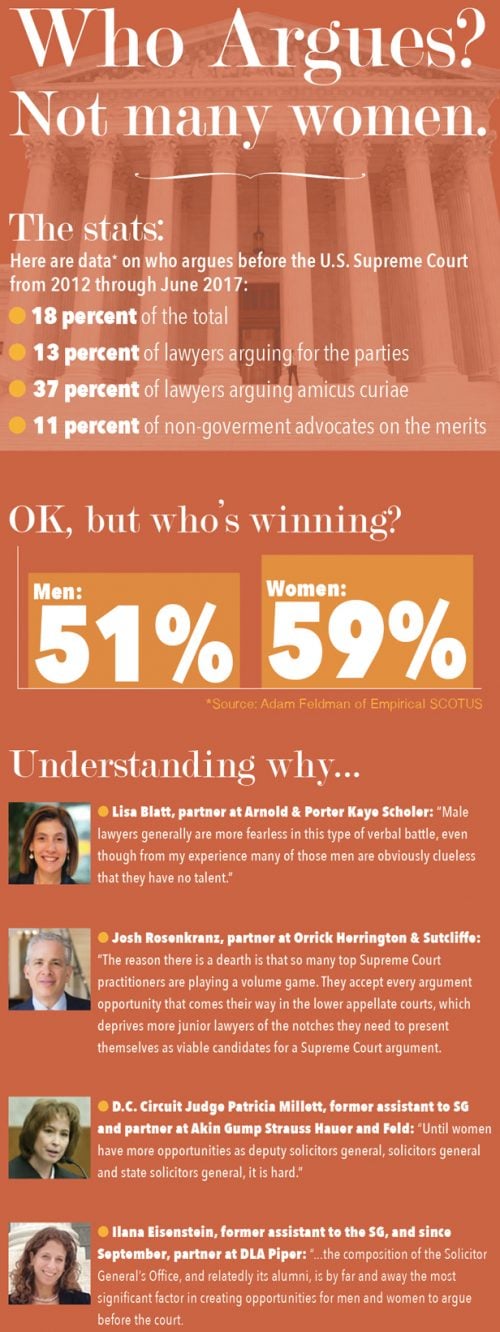Why Are There So Few Women SCOTUS Advocates?
New research shows women are significantly underrepresented in the elite ranks of advocates who argue before the court. Tony Mauro asked practitioners why and what can done about it.
October 25, 2017 at 04:12 PM
40 minute read

Recent research has revived concern about a persistent and undeniable aspect of U.S. Supreme Court practice: Women are significantly underrepresented among the ranks of advocates who argue before the court.
From 2012 through the term that ended in June, just under 18 percent of the advocates before the high court were women, according to Adam Feldman of Empirical SCOTUS. Only 13 percent of lawyers arguing for the parties in a case were women, while women made up almost a third of those arguing amicus curiae. And when female lawyers from the federal government are taken out of the equation, only 11 percent of advocates on the merits were women.
In recent years, the solicitor general's office has been a rich source of female advocates. (View a chart of the busiest women SCOTUS advocates here.)
 While not delving deeply into the reasons for the dearth of women, Feldman ruled out one possibility: that men have better win rates than women. “To the contrary, the statistics actually point to women performing better than men during these years,” Feldman wrote. “While the male attorney win rate is at 51 percent, the female win rate is eight percent higher at 59 percent.”
While not delving deeply into the reasons for the dearth of women, Feldman ruled out one possibility: that men have better win rates than women. “To the contrary, the statistics actually point to women performing better than men during these years,” Feldman wrote. “While the male attorney win rate is at 51 percent, the female win rate is eight percent higher at 59 percent.”
So what is the reason for the gender deficit, and what can be done about it?
Lisa Blatt of Arnold & Porter Kaye Scholer has top creds in this area—she has argued 35 cases at the court, more than any other woman in history. She raised eyebrows in 2010 when she offered her own theory.
In a talk before the Chautauqua Institution, reprinted in The Green Bag, Blatt said, “In my view a lot of the problem results from the fact that litigation requires a war-like mentality. … Male lawyers generally are more fearless in this type of verbal battle, even though from my experience many of those men are obviously clueless that they have no talent. I've heard countless women—but not a single man—say to me: 'I could never stand up before the Supreme Court; it would be way too stressful.'”
We asked Blatt and other Supreme Court practitioners for their current thinking on why so few women argue before the Supreme Court, and what can or should be done about it. Also included are remarks Judge Patricia Millett of the U.S. Court of Appeals for the D.C. Circuit made at a recent forum on women and the court.
 Lisa Blatt, partner at Arnold & Porter Kaye Scholer: “I obviously agree the Supreme Court bar and those arguing from private law firms in the court are overwhelmingly male. Two reasons should answer both of your questions.
Lisa Blatt, partner at Arnold & Porter Kaye Scholer: “I obviously agree the Supreme Court bar and those arguing from private law firms in the court are overwhelmingly male. Two reasons should answer both of your questions.
“First, there are five former, all-male SGs who are active practitioners: Seth [Waxman], Ted [Olson], Paul [Clement], Greg [Garre] and Don [Verrilli], and three acting: Walter [Dellinger], Neal [Katyal] and Ian [Gershengorn]. That equals eight. There are no women at these ranks. Period.
“Second, (and many women might well disagree with me) women do not often come across as aggressive, fearless, and confident as their male counterparts, even though women are typically supremely more qualified than these men. These factors either alone or in combination can be lethal when it comes to the number of women arguing before the court.”
 Josh Rosenkranz, partner at Orrick Herrington & Sutcliffe: “The reason there is a dearth is that so many top Supreme Court practitioners are playing a volume game. They accept every argument opportunity that comes their way in the lower appellate courts, which deprives more junior lawyers of the notches they need to present themselves as viable candidates for a Supreme Court argument. And then they rack up Supreme Court arguments like Christmas tree ornaments, refusing to steer them—even the pro bono cases—to colleagues who do have significant notches in their belts.
Josh Rosenkranz, partner at Orrick Herrington & Sutcliffe: “The reason there is a dearth is that so many top Supreme Court practitioners are playing a volume game. They accept every argument opportunity that comes their way in the lower appellate courts, which deprives more junior lawyers of the notches they need to present themselves as viable candidates for a Supreme Court argument. And then they rack up Supreme Court arguments like Christmas tree ornaments, refusing to steer them—even the pro bono cases—to colleagues who do have significant notches in their belts.
“I've vowed to my partners that I will not argue more than 10 cases a year, which means steering a significant number of argument opportunities to other colleagues who are building their practices. … I will work to credentialize those colleagues and resist pressures to take the lead, even if the client says that we are bidding against an appellate titan. This actually serves my business model well. If I argued 15 or 20 cases a year, I simply could not dig in to any of them or own the briefs the way I feel comfortable doing.
“Second, I am also striving to limit my Supreme Court arguments to two cases a term. When we take pro bono cases at the cert. level, I almost always condition it on an 'Orrick lawyer' arguing the case rather than committing that I will argue the case. And then I work to make sure the clients spend time with other colleagues and get comfortable with them taking the lead.”
 Ilana Eisenstein, former assistant to the SG, and since September, partner at DLA Piper: “Women's underrepresentation at the Supreme Court lectern has nothing to do with women's performance before the court. The female advocates I have seen before the court are as fearless, zealous and aggressive as anyone. Any client would be well served to have them representing them at oral argument before the Supreme Court.
Ilana Eisenstein, former assistant to the SG, and since September, partner at DLA Piper: “Women's underrepresentation at the Supreme Court lectern has nothing to do with women's performance before the court. The female advocates I have seen before the court are as fearless, zealous and aggressive as anyone. Any client would be well served to have them representing them at oral argument before the Supreme Court.
“Rather, the composition of the Solicitor General's Office, and relatedly its alumni, is by far and away the most significant factor in creating opportunities for men and women to argue before the court. Of the advocates with five or more arguments before the Supreme Court [in Feldman's study], nearly all were either (1) currently a member of the Solicitor General's Office or (2) alumni of the Solicitor General's Office.
“The good news is that, during my tenure at the Solicitor General's Office, we had near gender-parity among the assistants to the solicitor general. As those female assistants move on to private practice—as I have done recently in joining DLA Piper, and as have my former SG Office colleagues, Sarah Harrington [Goldstein & Russell] and Ginger Anders [Munger, Tolles & Olson]—I would expect the percentage of private female lawyers appearing at the Supreme Court lectern will commensurately increase. Nonetheless, until more women are chosen to serve in the posts of solicitor general, acting solicitor general, and deputies to the solicitor general—who by tradition and position get a greater share of Supreme Court arguments, and who continue that trend after leaving office—I don't expect women to appear in equal numbers at Supreme Court arguments.”
 D.C. Circuit Judge Patricia Millett, former assistant to SG and partner at Akin Gump Strauss Hauer and Feld: “It's hard in private practice. You do have this very specialized bar. When in private practice, there are only so many cases and you're competing consistently against other people who left the solicitor general's office—former solicitors general and deputy solicitors general. We had one female solicitor general for one year and she [Elena Kagan] got a better job.”
D.C. Circuit Judge Patricia Millett, former assistant to SG and partner at Akin Gump Strauss Hauer and Feld: “It's hard in private practice. You do have this very specialized bar. When in private practice, there are only so many cases and you're competing consistently against other people who left the solicitor general's office—former solicitors general and deputy solicitors general. We had one female solicitor general for one year and she [Elena Kagan] got a better job.”
“This is the pipeline. Until women have more opportunities as deputy solicitors general, solicitors general and state solicitors general, it is hard. I found it very hard to compete for Supreme Court cases in private practice.”
 Neal Katyal, partner at Hogan Lovells and former acting solicitor general: “There is a lack of diversity in Supreme Court oral arguments along every dimension—gender, race, religion, orientation, etc. I do think hiring and mentoring are critical to fixing this. I was always impressed by Justice [Stephen] Breyer's hiring of clerks—which was constantly half or more women. And I've tried hard to emulate that in all my hiring. Hogan Lovells' appellate group is half women and indeed has more women than men partners now, and is co-led by one of the very best advocates, hands down, in the nation [Cate Stetson]. So it's not surprising that the three associates we sent to the Solicitor General's Office had two women and one Asian-American man. But we can do better, and the new statistics highlight the need for us all to do more.”
Neal Katyal, partner at Hogan Lovells and former acting solicitor general: “There is a lack of diversity in Supreme Court oral arguments along every dimension—gender, race, religion, orientation, etc. I do think hiring and mentoring are critical to fixing this. I was always impressed by Justice [Stephen] Breyer's hiring of clerks—which was constantly half or more women. And I've tried hard to emulate that in all my hiring. Hogan Lovells' appellate group is half women and indeed has more women than men partners now, and is co-led by one of the very best advocates, hands down, in the nation [Cate Stetson]. So it's not surprising that the three associates we sent to the Solicitor General's Office had two women and one Asian-American man. But we can do better, and the new statistics highlight the need for us all to do more.”

Recent research has revived concern about a persistent and undeniable aspect of U.S. Supreme Court practice: Women are significantly underrepresented among the ranks of advocates who argue before the court.
From 2012 through the term that ended in June, just under 18 percent of the advocates before the high court were women, according to Adam Feldman of Empirical SCOTUS. Only 13 percent of lawyers arguing for the parties in a case were women, while women made up almost a third of those arguing amicus curiae. And when female lawyers from the federal government are taken out of the equation, only 11 percent of advocates on the merits were women.
In recent years, the solicitor general's office has been a rich source of female advocates. (View a chart of the busiest women SCOTUS advocates here.)
 While not delving deeply into the reasons for the dearth of women, Feldman ruled out one possibility: that men have better win rates than women. “To the contrary, the statistics actually point to women performing better than men during these years,” Feldman wrote. “While the male attorney win rate is at 51 percent, the female win rate is eight percent higher at 59 percent.”
While not delving deeply into the reasons for the dearth of women, Feldman ruled out one possibility: that men have better win rates than women. “To the contrary, the statistics actually point to women performing better than men during these years,” Feldman wrote. “While the male attorney win rate is at 51 percent, the female win rate is eight percent higher at 59 percent.”
So what is the reason for the gender deficit, and what can be done about it?
Lisa Blatt of
In a talk before the Chautauqua Institution, reprinted in The Green Bag, Blatt said, “In my view a lot of the problem results from the fact that litigation requires a war-like mentality. … Male lawyers generally are more fearless in this type of verbal battle, even though from my experience many of those men are obviously clueless that they have no talent. I've heard countless women—but not a single man—say to me: 'I could never stand up before the Supreme Court; it would be way too stressful.'”
We asked Blatt and other Supreme Court practitioners for their current thinking on why so few women argue before the Supreme Court, and what can or should be done about it. Also included are remarks Judge Patricia Millett of the U.S. Court of Appeals for the D.C. Circuit made at a recent forum on women and the court.
 Lisa Blatt, partner at
Lisa Blatt, partner at
“First, there are five former, all-male SGs who are active practitioners: Seth [Waxman], Ted [Olson], Paul [Clement], Greg [Garre] and Don [Verrilli], and three acting: Walter [Dellinger], Neal [Katyal] and Ian [Gershengorn]. That equals eight. There are no women at these ranks. Period.
“Second, (and many women might well disagree with me) women do not often come across as aggressive, fearless, and confident as their male counterparts, even though women are typically supremely more qualified than these men. These factors either alone or in combination can be lethal when it comes to the number of women arguing before the court.”
 Josh Rosenkranz, partner at
Josh Rosenkranz, partner at
“I've vowed to my partners that I will not argue more than 10 cases a year, which means steering a significant number of argument opportunities to other colleagues who are building their practices. … I will work to credentialize those colleagues and resist pressures to take the lead, even if the client says that we are bidding against an appellate titan. This actually serves my business model well. If I argued 15 or 20 cases a year, I simply could not dig in to any of them or own the briefs the way I feel comfortable doing.
“Second, I am also striving to limit my Supreme Court arguments to two cases a term. When we take pro bono cases at the cert. level, I almost always condition it on an 'Orrick lawyer' arguing the case rather than committing that I will argue the case. And then I work to make sure the clients spend time with other colleagues and get comfortable with them taking the lead.”
 Ilana Eisenstein, former assistant to the SG, and since September, partner at
Ilana Eisenstein, former assistant to the SG, and since September, partner at
“Rather, the composition of the Solicitor General's Office, and relatedly its alumni, is by far and away the most significant factor in creating opportunities for men and women to argue before the court. Of the advocates with five or more arguments before the Supreme Court [in Feldman's study], nearly all were either (1) currently a member of the Solicitor General's Office or (2) alumni of the Solicitor General's Office.
“The good news is that, during my tenure at the Solicitor General's Office, we had near gender-parity among the assistants to the solicitor general. As those female assistants move on to private practice—as I have done recently in joining
 D.C. Circuit Judge Patricia Millett, former assistant to SG and partner at
D.C. Circuit Judge Patricia Millett, former assistant to SG and partner at
“This is the pipeline. Until women have more opportunities as deputy solicitors general, solicitors general and state solicitors general, it is hard. I found it very hard to compete for Supreme Court cases in private practice.”
 Neal Katyal, partner at
Neal Katyal, partner at
This content has been archived. It is available through our partners, LexisNexis® and Bloomberg Law.
To view this content, please continue to their sites.
Not a Lexis Subscriber?
Subscribe Now
Not a Bloomberg Law Subscriber?
Subscribe Now
NOT FOR REPRINT
© 2025 ALM Global, LLC, All Rights Reserved. Request academic re-use from www.copyright.com. All other uses, submit a request to [email protected]. For more information visit Asset & Logo Licensing.
You Might Like
View All
Supreme Court Justices Have 'Variety of Views' on Ethics, Kagan Says

Can Congress Tax Unrealized Gains as Income? Supreme Court May Decide

This Judge, Who Grew up in Miami-Dade, Just Had a Street Named After Her

Court Overturns $185M Fee Award for Quinn Emanuel in ACA Litigation
Trending Stories
- 1OCR Issues 'Dear Colleagues' Letter Regarding AI in Medicine
- 2Corporate Litigator Joins BakerHostetler From Fish & Richardson
- 3E-Discovery Provider Casepoint Merges With Government Software Company OPEXUS
- 4How I Made Partner: 'Focus on Being the Best Advocate for Clients,' Says Lauren Reichardt of Cooley
- 5People in the News—Jan. 27, 2025—Barley Snyder
Who Got The Work
J. Brugh Lower of Gibbons has entered an appearance for industrial equipment supplier Devco Corporation in a pending trademark infringement lawsuit. The suit, accusing the defendant of selling knock-off Graco products, was filed Dec. 18 in New Jersey District Court by Rivkin Radler on behalf of Graco Inc. and Graco Minnesota. The case, assigned to U.S. District Judge Zahid N. Quraishi, is 3:24-cv-11294, Graco Inc. et al v. Devco Corporation.
Who Got The Work
Rebecca Maller-Stein and Kent A. Yalowitz of Arnold & Porter Kaye Scholer have entered their appearances for Hanaco Venture Capital and its executives, Lior Prosor and David Frankel, in a pending securities lawsuit. The action, filed on Dec. 24 in New York Southern District Court by Zell, Aron & Co. on behalf of Goldeneye Advisors, accuses the defendants of negligently and fraudulently managing the plaintiff's $1 million investment. The case, assigned to U.S. District Judge Vernon S. Broderick, is 1:24-cv-09918, Goldeneye Advisors, LLC v. Hanaco Venture Capital, Ltd. et al.
Who Got The Work
Attorneys from A&O Shearman has stepped in as defense counsel for Toronto-Dominion Bank and other defendants in a pending securities class action. The suit, filed Dec. 11 in New York Southern District Court by Bleichmar Fonti & Auld, accuses the defendants of concealing the bank's 'pervasive' deficiencies in regards to its compliance with the Bank Secrecy Act and the quality of its anti-money laundering controls. The case, assigned to U.S. District Judge Arun Subramanian, is 1:24-cv-09445, Gonzalez v. The Toronto-Dominion Bank et al.
Who Got The Work
Crown Castle International, a Pennsylvania company providing shared communications infrastructure, has turned to Luke D. Wolf of Gordon Rees Scully Mansukhani to fend off a pending breach-of-contract lawsuit. The court action, filed Nov. 25 in Michigan Eastern District Court by Hooper Hathaway PC on behalf of The Town Residences LLC, accuses Crown Castle of failing to transfer approximately $30,000 in utility payments from T-Mobile in breach of a roof-top lease and assignment agreement. The case, assigned to U.S. District Judge Susan K. Declercq, is 2:24-cv-13131, The Town Residences LLC v. T-Mobile US, Inc. et al.
Who Got The Work
Wilfred P. Coronato and Daniel M. Schwartz of McCarter & English have stepped in as defense counsel to Electrolux Home Products Inc. in a pending product liability lawsuit. The court action, filed Nov. 26 in New York Eastern District Court by Poulos Lopiccolo PC and Nagel Rice LLP on behalf of David Stern, alleges that the defendant's refrigerators’ drawers and shelving repeatedly break and fall apart within months after purchase. The case, assigned to U.S. District Judge Joan M. Azrack, is 2:24-cv-08204, Stern v. Electrolux Home Products, Inc.
Featured Firms
Law Offices of Gary Martin Hays & Associates, P.C.
(470) 294-1674
Law Offices of Mark E. Salomone
(857) 444-6468
Smith & Hassler
(713) 739-1250






